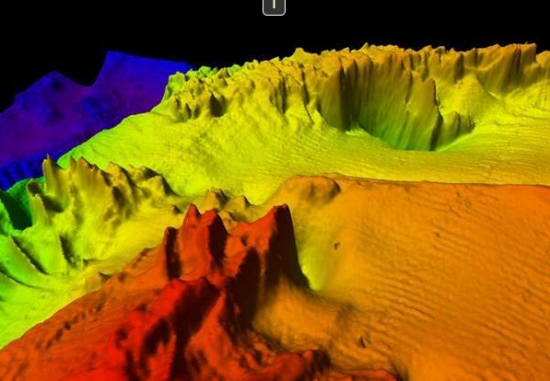Bo Petersen
Source - http://www.postandcourier.com/article/20130707/PC16/130709582/1177/scientists-want-to-study-bulls-scarp-ocean-bottom-archaeological-site-that-was-ice-age-coast

College of Charleston geology professor Scott Harris uses a sonar image to explain Bulls Scarp, 50 miles off the coast of South Carolina, has peaks and valleys. Brad Nettles/Staff
Anyone who stood on a rock ledge a few hundred feet above an ocean-swept river delta could have watched for walruses or whales among the icebergs and searched for woolly mammoths tracking across the barren savannah behind.

Bulls Scarp as seen in a color-enhanced sonar image representation.
Bulls Scarp could be the most fascinating and important archaeological site waiting to be surveyed in the region. There’s just one little problem: That Ice Age rock ledge is under about 140 feet of seawater.
But a team of scientists recently studied and mapped it from the ocean surface. Now the team is looking for partners to go back.
“We haven’t been on the bottom to look for artifacts and that’s what we’re trying to do. We feel very strongly this area would have held populations of people,” said Scott Harris, College of Charleston geology professor.
“I think it’s fantastic. I can just picture it in my mind. We know these hard grounds were occupied by herd animals and people at the time,” said George Sedberry, National Marine Sanctuaries science coordinator.
Bones and tools
Bulls Scarp, located east of Bulls Bay, is a nose of rock rising from a scarp face that drops more than 500 feet. Some 18,000 years ago, this was the shoreline.
Harris took part in the 2011 research, mapping with a crew composed partly of College of Charleston students. Sedberry was aboard, too; his primary interest was snapper-grouper and other fish species. In the Caribbean, those fish are known to go hundreds of miles to find coral ledges with a northeast face over deep water; they lay eggs that are washed in the currents to deep water away from predators, then eddy back in as larger juveniles.
The scarp has a face like that, and it too attracts those fish.
When the mapping began to detail the promontory and the remains of the delta, Harris did a double-take. He also has archaeological training, and this looked a lot like submerged sites in other places that have been found to hold prehistoric animal bones and evidence of human tools.
That caught Sedberry’s attention: A place that draws game species now would have drawn them then, and hunters after that. Woolly mammoth bones have been found in Gray’s Reef National Marine Sanctuary off the Georgia coast, where Sedberry served as superintendent.
The team put together a paper that was published this spring to an international reception.
“It’s really quite stunning. It’s looking very promising as far as I’m concerned,” said Jon Leader, state archaeologist.
The cutting edge
The almost surreal possibility of prehistoric life on Bulls Scarp has some very modern significance for what it means to be South Carolinian.
The Clovis people, tribes who lived some 13,000 years ago, were regarded as the first Americans. Evidence of their existence has been found at the Topper site in Allendale County among others. More recent research suggests that people might have lived here even earlier, pre-Clovis.
But so far, the blade artifacts found are few and far between and tend to be broken shards. Among archaeologists, the debate is cutting-edge.
If tools remain along Bulls Scarp, they may be larger artifacts lying on hard rock where currents scour away finer sediments. In other words, they could be exposed. And very possibly intact. They could decide the controversy.
“It literally would undermine archaeological regimen,” Harris said. “Pre-Clovis sites still freak people out.”
Specialized search
Finding artifacts on Bulls Scarp, though, is a little tougher than grabbing a trowel. The ledge sits below scuba depth, down where divers must use a gas mix and have only a small amount of time on a dark bottom. Even submersibles would have to cover miles searching for pieces that would look like more rock.
“We have a hard enough time finding them on land. (On the scarp) it would take a very specialized group of people to do it,” Harris said. And they would need a ride.
Fortunately for the team, underwater research off the Carolinas is ongoing; members are bidding for grants to take part in another multi-specialty expedition like the mapping cruise.
Harris’ work is significant to the state, Leader said, and there’s another, easy-to-overlook importance in what he’s doing. College of Charleston students took part in the mapping project and ideally would take part in any further research.
“He is a researcher who is not only doing the work but teaching people to continue the work, imparting the passion. That’s hard to do,” Leader said.
A potential Bulls Scarp archaeological find would be valuable enough; having students actively involved would be invaluable.
“I think we should be keeping a close eye on what he comes up with,” Leader said.